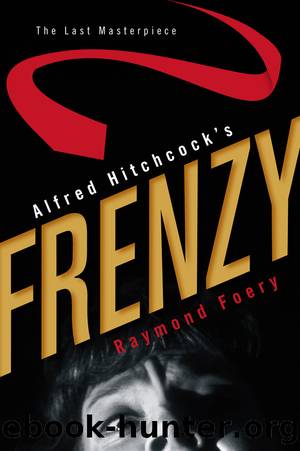Alfred Hitchcock's Frenzy by Foery Raymond

Author:Foery, Raymond [Foery, Raymond]
Language: eng
Format: epub
Publisher: Scarecrow Press Inc.
Published: 2011-12-31T16:00:00+00:00
9
Shooting the Signature Sequences, Part II
Hitchcock as the Master of Mise-en-Scene and the Moving Camera
Hitchcockâs appellation as the âmaster of suspenseâ is so much a part of motion picture historical lore that it would indeed be quite surprising to find anyone familiar with even a modicum of the story of cinema who has not encountered this particular honorific title. How and when the title was first conferred remains a mystery to me; I have always assumed that one could ascribe it to the creative energies of some minion working in the studio publicity mill under perhaps either David O. Selznick or Lew Wasserman.1 What I would add here is another honorific title that could easily be conferred on the legendary director: âmaster of spaceââor master, at least, of the moving camera. For I think that as we continue to evaluate the great pioneers of the first century of cinema, we continue to marvel at the ways by which some of them managed to so comprehensively master their craft. As each year brings the sad announcement of the passing of yet another of the giants of this early period, we come more and more to appreciate the means of expression that they so fervently embraced during such a formative time. Of all of these pioneers, Alfred Hitchcock has easily received the most critical attention. While I am not, in this work, going to begin to touch upon the enormous body of scholarly work that has created a virtual cottage industry around his name, I will simply note as a signifier of Hitchcockâs universally accepted importance that the superb analyst Robin Wood has famously compared Hitchcockâs work to that of William Shakespeare.2
Like Shakespeare, Hitchcockâs lasting significance is not so much in the tale that is told but in how that tale is told. The story of King Henry V, for example, was well known to Shakespeareâs contemporaries; his version of it, nevertheless, has come to stand as the official portrait. So with Hitchcock: We are not so moved, it seems to me, by the actual stories he tellsâof men on the run, crimes of passion, spy intrigue, domestic turmoil; rather, we are impressed by the means he engages to relay these stories to us. Hitchcock, then, will continue to be known as a âmaster of cinemaâ because he became a master at utilizing uniquely cinematic techniques to communicate his often relatively ordinary and occasionally even somewhat banal messages. Hitchcock often saidâmost notably in his series of interviews with François Truffautâthat what he was pursuing in his work was a kind of expressionism that he called, simply, âpure cinema.â3 What he meant by this, we can now conclude, is that there is in the nature of cinematic expression the ability to communicate without words (which would be literature) and without dramatic gesture (which would be theater).
Hitchcock wished in his work to find that particular means of communication that could not be replicated by any other artistic form; for him, there was a kind of âlanguageâ of cinema, and he was determined to write its grammar.
Download
This site does not store any files on its server. We only index and link to content provided by other sites. Please contact the content providers to delete copyright contents if any and email us, we'll remove relevant links or contents immediately.
Shoot Sexy by Ryan Armbrust(17659)
Portrait Mastery in Black & White: Learn the Signature Style of a Legendary Photographer by Tim Kelly(16953)
Adobe Camera Raw For Digital Photographers Only by Rob Sheppard(16904)
Photographically Speaking: A Deeper Look at Creating Stronger Images (Eva Spring's Library) by David duChemin(16622)
Bombshells: Glamour Girls of a Lifetime by Sullivan Steve(13975)
Art Nude Photography Explained: How to Photograph and Understand Great Art Nude Images by Simon Walden(12975)
Perfect Rhythm by Jae(5324)
Pillow Thoughts by Courtney Peppernell(4208)
The Book of Joy by Dalai Lama(3901)
Good by S. Walden(3488)
The Pixar Touch by David A. Price(3364)
A Dictionary of Sociology by Unknown(3031)
Fantastic Beasts: The Crimes of Grindelwald by J. K. Rowling(2994)
Humans of New York by Brandon Stanton(2835)
Stacked Decks by The Rotenberg Collection(2812)
Read This If You Want to Take Great Photographs by Carroll Henry(2664)
On Photography by Susan Sontag(2575)
Insomniac City by Bill Hayes(2499)
Photographic Guide to the Birds of Indonesia by Strange Morten;(2490)
